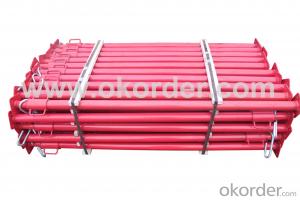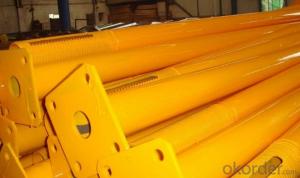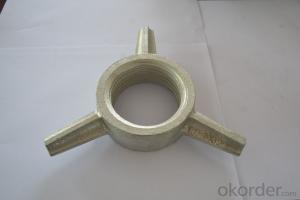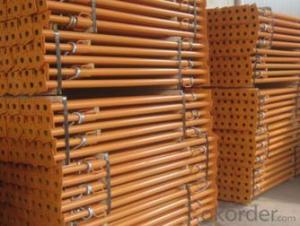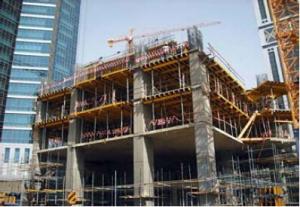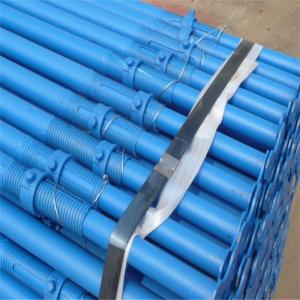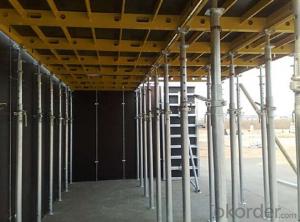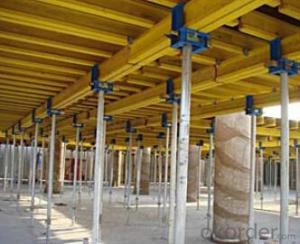Stable and durable steel scaffolding shoring prop
- Loading Port:
- Tianjin
- Payment Terms:
- TT OR LC
- Min Order Qty:
- 10000 PCS
- Supply Capability:
- 10000 PCS/month
OKorder Service Pledge
OKorder Financial Service
You Might Also Like
Quick Details
| Model Number: | SP scaffolding shoring prop | ||||
| Material: | Q235 steel pipe | Color: | dark red, green, blue | Surface treatment: | painted, powder coated, galvanized |
| Certification: | SGS;BV | Length: | 1600-4000mm | Thickness: | 1.8/2.0/2.2/2.5/3.0mm |
| Technique: | CO2 arc welded | Inner tube diameter: | 40/48mm | Outer tube diameter: | 48/56/60mm |
| Application: | scaffolding shoring prop for slab and formwork supporting |
Packaging & Delivery
| Packaging Detail: | 1.Scaffolding shoring prop is in a bundle with a wire which is in bare package. 2.One 20 GP container can load around 1500-2000 pieces of props. |
| Delivery Detail: | 10-20 days after deposit |
Specifications
scaffolding shoring prop
1.For slab supporting
2.CO2 arc welded technique
3.High loading capacity
4.Rust-proof
SpecificationsChina)
| Product | Model | Specifications |
scaffolding shoring prop | Inner tube diameter |
40/48mm |
| Outer tube diameter |
48/56/60mm | |
| Tube thickness |
1.8/2.0/2.2/2.5/3mm | |
| Adjustable length | 1600-2900mm 1800-3200mm 2000-3600mm 2200-4000mm |
*We can provide diffenet sizes and types of scaffolding shoring prop for you .
- Q:Can steel props be used for supporting temporary exhibition stands?
- Certainly, temporary exhibition stands can be supported by steel props. These props possess robustness and longevity, rendering them an apt choice for carrying the weight of exhibition stands and the materials employed in their assembly. Adjusting them to the desired height is a breeze, and they furnish stability and reinforcement to the structure. Furthermore, steel props can be utilized in diverse arrangements to accommodate a range of stand designs and layouts. In conclusion, steel props emerge as a dependable option for supporting temporary exhibition stands.
- Q:What are the different types of steel used in steel props?
- Steel props used in construction can be made from various types of steel, each possessing unique properties and advantages. Let's explore these different types: 1. Mild Steel: Widely utilized in steel props, mild steel stands out for its low carbon content, enabling excellent weldability and formability. These props are cost-effective and readily available, making them a popular option for construction projects. 2. High-strength Low-alloy (HSLA) Steel: By combining carbon steel with small amounts of elements like vanadium or niobium, HSLA steel props offer enhanced strength and superior performance compared to mild steel props. They find great utility in applications requiring additional strength and durability. 3. Stainless Steel: Suited for environments with high humidity or exposure to chemicals, stainless steel props exhibit corrosion resistance and high strength. They are commonly employed in marine construction, food processing plants, and other corrosion-sensitive settings. 4. Carbon Steel: With a higher carbon content than mild steel, carbon steel props deliver increased strength and hardness. These props are ideal for heavy-duty applications demanding high load-bearing capacity, such as supporting large structures or heavy machinery. 5. Alloy Steel: Alloy steel props are created by introducing alloying elements like manganese, chromium, or nickel to carbon steel. This improves their mechanical properties, including strength, hardness, and wear resistance. They find widespread use in industrial settings, construction machinery, and mining equipment. 6. Tool Steel: Designed for exceptional hardness, toughness, and wear resistance, tool steel props excel in applications where they must endure heavy impacts or extreme wear. They are commonly employed in forging dies, cutting tools, or molds. Each type of steel possesses its own strengths and weaknesses, and the selection of steel for steel props hinges on specific project requirements, including load-bearing capacity, corrosion resistance, and cost-effectiveness.
- Q:Can steel props be used for supporting mezzanine floors?
- Yes, steel props can be used for supporting mezzanine floors. Steel props are strong and sturdy, making them an ideal choice for providing support to mezzanine floors. They can effectively bear the weight of the mezzanine structure and any additional loads placed on it. Additionally, steel props are adjustable, allowing for easy installation and ensuring that the mezzanine floor is level and secure. They are also highly durable and can withstand the constant pressure and load-bearing requirements of a mezzanine floor. Overall, steel props are a reliable and efficient option for supporting mezzanine floors.
- Q:Subway construction steel support axial force design value of KN/m, the construction to be converted into MPa, how to calculate?
- If:The design of prestress value is 300KNJack cross-sectional area of 0.017671 square metersApply prestress = Design prestress value / Jack cross-sectional area =300/0.017671/1000=1.70MPa
- Q:Can steel props be used in the construction of skyscrapers or tall buildings?
- Yes, steel props can be used in the construction of skyscrapers or tall buildings. Steel props provide temporary support to the structure during construction, allowing for the safe installation of floors and beams at various heights. These props are strong, durable, and adjustable, making them suitable for supporting the weight and load of tall structures.
- Q:Can steel props be used for temporary support in offshore platforms?
- Temporary support in offshore platforms can be provided using steel props. These props are commonly used in construction to support temporary structures or offer additional support to existing ones. In the case of offshore platforms, steel props serve to temporarily support the platform during construction, maintenance, or repair work. Offshore platforms face various loads and forces, including waves, wind, and the weight of equipment and personnel. Additional loads may be applied during construction or maintenance, necessitating temporary support for platform stability and safety. Steel props, typically made from high-strength steel, can be easily adjusted to the desired height and load-bearing capacity. They offer a stable and reliable solution for temporary structural support, enabling necessary work to be completed. However, it is crucial to ensure that the steel props used for temporary support in offshore platforms are designed and manufactured to meet the specific requirements and safety standards of the offshore industry. Key considerations include corrosion resistance, load capacity, and compliance with relevant regulations and guidelines. In conclusion, steel props can be employed for temporary support in offshore platforms. However, it is essential to select suitable props that are specifically designed and manufactured to meet the unique demands of the offshore environment, guaranteeing platform safety and stability.
- Q:Are there any alternatives to steel props?
- Yes, there are several alternatives to steel props in construction. Some of these alternatives include: 1. Aluminum props: These are lightweight and highly durable, making them a popular choice for temporary support in construction projects. Aluminum props also have a higher load-bearing capacity compared to steel props. 2. Timber props: Timber props are commonly used in construction for their affordability and ease of use. They are typically made from high-quality timber and can be easily adjusted to different heights. However, timber props may have a lower load-bearing capacity compared to steel or aluminum props. 3. Fiberglass props: These props are lightweight, corrosion-resistant, and non-conductive, making them suitable for use in sensitive or hazardous environments. Fiberglass props are also easy to handle and can be adjusted to different heights. 4. Composite props: Composite props are made from a combination of materials such as fiberglass, carbon fiber, and epoxy resin. They offer high strength-to-weight ratios, corrosion resistance, and excellent load-bearing capacity. Composite props are often used in applications where weight reduction and durability are critical. 5. Hydraulic props: These props use hydraulic pressure to provide support. They are highly adjustable and can be easily controlled to achieve precise height and load requirements. Hydraulic props are commonly used in applications where frequent adjustments are needed, such as in formwork or shoring systems. It's important to consider the specific requirements of each construction project and consult with structural engineers or construction professionals to determine the most suitable alternative to steel props.
- Q:Can steel props be used in different construction applications?
- Various construction applications can utilize steel props, which are also known as adjustable steel props or steel shores. These versatile support systems are commonly employed in construction to provide temporary support during projects involving beams, walls, and ceilings. Steel props can be adjusted in height to accommodate different construction needs. They can be employed to support formwork while concrete is poured, offer temporary support to walls or beams during demolition or renovation, or even serve as temporary supports for pre-existing structures during repair or reinforcement. The robustness and durability of steel props make them suitable for a wide range of construction applications. They possess the ability to withstand heavy loads and can be easily adjusted to the desired height, ensuring stability and safety at the construction site. Moreover, steel props offer several advantages, including ease of installation, reusability, and versatility. They can be installed, adjusted, and removed quickly and effortlessly, resulting in time and labor savings. Additionally, their reusability makes them a cost-effective solution for multiple construction projects. In conclusion, steel props are indeed applicable to diverse construction scenarios due to their adjustable height, strength, durability, and versatility. They play a crucial role in providing temporary support and stability during construction or renovation projects, making them an indispensable tool for professionals in the construction industry.
- Q:Are there any weight restrictions when using steel props?
- Yes, there are weight restrictions when using steel props. The weight capacity of steel props varies depending on their size and specifications. It is important to consult the manufacturer's guidelines and follow the recommended weight limits to ensure the safe and proper use of steel props.
- Q:What are the main components of a steel prop?
- The main components of a steel prop include a steel tube, an adjustable screw jack, and a base plate.
1. Manufacturer Overview |
|
|---|---|
| Location | |
| Year Established | |
| Annual Output Value | |
| Main Markets | |
| Company Certifications | |
2. Manufacturer Certificates |
|
|---|---|
| a) Certification Name | |
| Range | |
| Reference | |
| Validity Period | |
3. Manufacturer Capability |
|
|---|---|
| a)Trade Capacity | |
| Nearest Port | |
| Export Percentage | |
| No.of Employees in Trade Department | |
| Language Spoken: | |
| b)Factory Information | |
| Factory Size: | |
| No. of Production Lines | |
| Contract Manufacturing | |
| Product Price Range | |
Send your message to us
Stable and durable steel scaffolding shoring prop
- Loading Port:
- Tianjin
- Payment Terms:
- TT OR LC
- Min Order Qty:
- 10000 PCS
- Supply Capability:
- 10000 PCS/month
OKorder Service Pledge
OKorder Financial Service
Similar products
New products
Hot products
Related keywords



